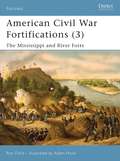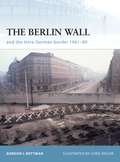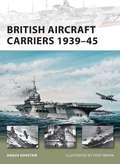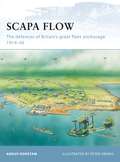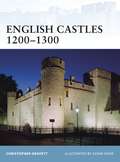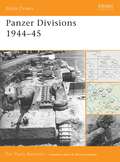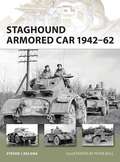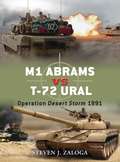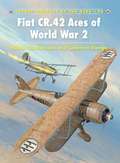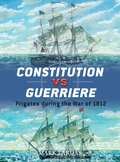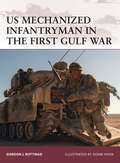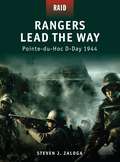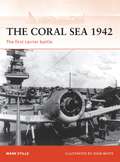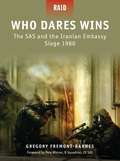- Table View
- List View
Japanese Castles in Korea 1592–98 (Fortress)
by Peter Dennis Stephen TurnbullThe Japanese invasion and occupation of Korea, which lasted from 1592 to 1598, was the only occasion in Japanese history when samurai aggression was turned against a foreign country. During the occupation of Korea the Japanese built 25 wajo or castles. Unlike the castles built in Japan, these fortifications were never developed or modernized after the Japanese departure. The details of late 16th-century castle construction are therefore better preserved than at many other sites. Written by Stephen Turnbull, an expert in the subject, this book examines the castles built by the Japanese in Korea, as well as the use made of existing Korean fortifications, particularly city walls. This resulted in curious hybrid fortifications that dominated the landscape until the Japanese were pushed out of the peninsula by a furious onslaught from huge Chinese armies.
American Civil War Fortifications: The Mississippi and River Forts (Fortress #68)
by Adam Hook Ron FieldThe Mississippi River played a decisive role in the American Civil War. The Confederate fortifications that controlled the lower Mississippi valley were put to the test in the lengthy Federal campaign of 1862-63. Vicksburg was a fortress city, known as the 'Gibraltar of the Confederacy', whose capture was seen as the key to victory in the war. This book explores the fortifications of the river valley, focusing on Vicksburg and its defences which boasted a network of forts, rifle pits and cannon embrasures surrounding the city, a well as examining the strengths and weaknesses of the fortifications when under siege. Also examined are numerous other fortified strongholds, including New Orleans, Port Hudson, New Madrid, and forts Henry and Donelson, all lavishly illustrated with full-colour artwork and cutaways.
The Berlin Wall and the Intra-German Border 1961-89 (Fortress)
by Gordon L. Rottman Chris TaylorThe border between East and West Germany was closed on 26 May 1953. On 13 August 1961 crude fences and walls were erected around West Berlin: the Berlin Wall had been created. The Wall encircled West Berlin for a distance of 155km, and its barriers and surveillance systems evolved over the years into an advanced obstacle network. The Intra-German Border ran from the Baltic Sea to the Czechoslovak border for 1,381km, and was where NATO forces faced the Warsaw Pact for the 45 years of the Cold War. This book examines the international situation that led to the establishment of the Berlin Wall and the IGB, and discusses how these barrier systems were operated, and finally fell.
German V-Weapon Sites 1943–45 (Fortress #72)
by Hugh Johnson Steven J. ZalogaDesigned to change the course of the war, the V weapons required ambitious plans to defend their expensive and complicated launch sites. Steven J Zaloga describes the configuration and planned deployment of heavy missile sites, as well as the unique Allied tactics developed to counter this threat, including a remote-control version of the B-17 bomber. From the V-1 ski sites to the mobile basing employed by the V-2 units and the other secret weapons bases like the 'V-3' high-pressure gun at Mimoyeques, this book examines the impact of these weapon systems and defences not only on the war but on modern weaponry. With many of the sites described still surviving today, this is a perfect companion for a tour of the V weapon sites built during World War II.
Japanese Castles AD 250–1540 (Fortress #74)
by Peter Dennis Stephen TurnbullDr Stephen Turnbull is internationally recognised for his research into and writing on Japanese military history. Here he applies his scholarship to an account of the evolution of Japanese defensive architecture and engineering, from early earthworks through to wooden and earth castles and, finally, the emergence of the stone towers that are so characteristic of the samurai. He also plots the adaptation of Japanese castles to accommodate the introduction of firearms. With unpublished photographs from the author's private collection and full-colour artwork, including detailed cutaways, this is an essential guide to the fascinating development of Japanese castles.
The Forts of New France in Northeast America 1600–1763: In Northeast America, 1600-1763 (Fortress)
by Brian Delf René Chartrand'New France' consisted of the area colonized and ruled by France in North America. This title takes a look at the lengthy chain of forts built by the French to guard the frontier in the American northeast, including Sorel, Chambly, St Jean, Carillon (Ticonderoga), Duquesne (Pittsburgh, PA), and Vincennes. These forts were of two types: the major stone forts, and other forts made of wood and earth, all of which varied widely in style from Vauban-type elements to cabins surrounded by a stockade. Some forts, such as Chambly, looked more like medieval castles in their earliest incarnations. René Chartrand examines the different types of forts built by the French, describing the strategic vision that led to their construction, their impact upon the British colonies and the Indian nations of the interior, and the French military technology that went into their construction.
The Los Banos Prison Camp Raid: The Philippines 1945 (Raid)
by Gordon L. Rottman Johnny Shumate Alan GillilandOn the southwest shore of Laguna de Bay in the Philippines stood the Los Banos Internment Camp. Held within were 2,147 starving POWs, surrounded by thousands of Japanese troops. As the desperate battle for Manila raged, only 130 Paratroopers could be spared for the rescue operation. Supported by Alamo Scouts, local guerrillas, and amphibious tractors, they seized the element of surprise, and rescued the POWs. It was a stunning triumph of courage and perfect timing in the face of overwhelming odds.
British Motor Gun Boat 1939–45 (New Vanguard #166)
by Tony Bryan Angus KonstamMotor Gun Boats were the "Spitfires of the Seas†? of the Royal Navy. Bristling with small-calibre guns and machine guns, they served in a variety of roles during the War. In the early war period they battled against German E-boats in the English Channel, then went on the offensive, searching the enemy shore for targets of opportunity. At other times, they ran support for Motor Torpedo Boats and were used to deliver commandos on various raids. Naval Warfare expert, Angus Konstam, tells the story of these small, but destructive boats, beginning with their design and development and carrying through to their operational use in both the European and Mediterranean theatres of World War II.
British Aircraft Carriers 1939–45 (New Vanguard)
by Tony Bryan Angus KonstamWith war against Germany looming, Britain pushed forward its carrier program in the late 1930s. In 1938, the Royal Navy launched the HMS Ark Royal, its first-ever purpose-built aircraft carrier. This was quickly followed by others, including the highly-successful Illustrious class. Smaller and tougher than their American cousins, the British carriers were designed to fight in the tight confines of the North Sea and the Mediterranean. Over the next six years, these carriers battled the Axis powers in every theatre, attacking Italian naval bases, hunting the Bismark, and even joining the fight in the Pacific. This book tells the story of the small, but resilient, carriers and the crucial role they played in the British war effort.
Scapa Flow: The defences of Britain’s great fleet anchorage 1914–45 (Fortress)
by Peter Dennis Angus KonstamA strategically important natural harbor in the Orkney Islands, Scapa Flow served as Britain's main fleet anchorage during World Wars I and II. In 1914 and again in 1939, the British began building a comprehensive defensive network by fortifying the entrances to Scapa Flow, and then extended these defenses to cover most of Orkney. By 1940, it had become an island fortress, the largest integrated defensive network of its kind in Europe, manned by as many as 50,000 Commonwealth troops. Backed by newly commissioned artwork, naval historian Angus Konstam tells the story of this mighty naval fortress, many pieces of which can still be seen on the island today.
English Castles 1200–1300 (Fortress)
by Adam Hook Christopher GravettThe simple castles raised after the Norman conquest had been developed throughout 11th and 12th centuries, whilst the introduction of Islamic and Byzantine fortification techniques from the late 12th century led to further developments in castle architecture. These fortifications were to be well tested throughout the course of the 13th century as England was riven by the conflict, characterized by prolonged sieges, between the monarchy and powerful magnates. As well as providing the focus for warfare, castles increasingly became the centres of their communities, providing a more permanent base for the lord, his family and retainers, as well as acting as centres for justice and administration.
Panzer Divisions 1944–45 (Battle Orders)
by Pier Paolo BattistelliThis volume provides a detailed examination on the late-war changes to the German Army Panzer forces and the formation of new units, from the collapse on the Eastern Front, through operations on the Western Front in Normandy and the Ardennes, to the final battle for Berlin in 1945. The major organizational changes that took place in this intensive period are examined, together with the adaptation of German armoured doctrine, tactics, and the command. Details of unit histories and operations, illustrated in colour maps, are also provided in this packed treatment.
T-62 Main Battle Tank 1965–2005 (New Vanguard)
by Steven J. Zaloga Tony BryanThe Soviet Army hastily developed the T-62 in a struggle to compete against the rapid proliferation of NATO tanks in the 1960s. It was essentially a modification of the widely-manufactured T-55 tank with the addition of a new 115mm gun. Within the USSR itself, the T-62 was quickly superseded, but it was widely exported, becoming a critical component of the Egyptian and Syrian armies in the 1973 Yom Kippur conflict and heavily influenced later designs of the M1 Abrams and Challenger tanks. In the first English-language history of this tank, Steven Zaloga examines the development of the T-62 using detailed combat descriptions to bring to life the operational history of this tank from the deserts of the Sinai to the harsh terrain of Afghanistan.
Staghound Armored Car 1942–62 (New Vanguard)
by Steven J. Zaloga Peter BullThe Staghound was a unique World War II armored vehicle designed and manufactured in the US, but intended solely for the British army. Since its combat debut in Italy in 1943 until the end of the war it had performed particularly valuable service in a reconnaissance role where its speed and armor ensured that it was able to extricate itself from trouble as required without additional support. This book examines the development of this category of armored cars and offers a detailed analysis of the extensive combat use of the Staghound in British service as well as in the service of other Allied countries including Canada, New Zealand and Poland.
M1 Abrams vs T-72 Ural: Operation Desert Storm 1991 (Duel #18)
by Steven J. Zaloga Jim LaurierThe Gulf War bore witness to a number of deadly encounters between these two great adversaries. Heavily armoured, highly mobile and capable of killing at over 2500m the M1 Abrams is, to this day, a veritable fighting machine. Superior to both Iraq's Soviet era T-55 and T-62 tanks, nearly all sources claim that no Abrams tank has ever been destroyed by enemy fire. Despite entering service in 1980, the M1 Abrams remained untested in combat until the Gulf War in 1991, where it was to be confronted by its archenemy the Iraqi-assembled Soviet-designed T-72. Entering production in 1971, the T-72 arguably outstripped its contemporaries in a balance of mobility, protection and firepower. By the time of Operation Desert Storm, however, the tables had turned and the tank suffered due to low quality ammunition and poorly trained crews. In this fascinating study, Steven Zaloga pits these two great fighting machines against one another, plotting the development of the Cold War until both tanks met in combat in the deserts of Iraq and Kuwait.
Fiat CR.42 Aces of World War 2 (Aircraft of the Aces)
by Richard Caruana Ludovico Slongo Håkan GustavssonThe Fiat CR.42, a logical development of the Fiat CR.32, was the last single-seat fighter biplane to be produced. It entered service with the Italian Regia Aeronautica in May 1939 before being exported to Belgium, Hungary and Sweden. Its combat debut came when the Belgian air force threw its fleet into action during the German invasion of the Low Countries on 10th May 1940. Despite being quickly overwhelmed, the Belgian pilots managed to make a number of aerial claims. The CR.42 became heavily involved in the fighting in North Africa and although it was gradually replaced by more modern fighters, it continued in a point defence and ground support role until the end of the war. Drawing on research from a range of sources, this book examines the extensive employment of the Italian fighter plane during the course of World War II.
Constitution vs Guerriere: Frigates during the War of 1812 (Duel)
by Peter Bull Giuseppe Rava Mark LardasFamed as a classic naval duel, a one-on-one clash between two sailing frigates offered the victor immeasurable fame and glory. During the War of 1812, the Royal Navy and United States Navy squared off in four such duels, the most famous that between the USS Constitution and HMS Guerrière. Ships and tactics between the two nations varied enormously, with the American navy favouring a revolutionary design of frigate, with twenty-four pounder guns and heavy structural timbers, while the British, used to fighting the French and Spanish navies, relied on smaller, eighteen-pounder frigates. Through first-hand accounts of these four single-ship actions and fascinating comparisons of artillery, crew ability and tactical achievements, this book offers an unparalleled insight into the ruthless reality of frigate battles in the War of 1812.
US Mechanized Infantryman in the First Gulf War (Warrior)
by Adam Hook Gordon L. RottmanIn many ways the end of the Vietnam War left the US army a spent force. Plagued by low morale, drug and race issues, and terrible public relations, the army faced an uphill climb in the effort to rebuild itself. The story of this reconstruction is mirrored in the rise of the Mechanized Infantryman. Deciding that the key to future conflict lay in highly trained and mobile warriors that could be delivered quickly to battle, the army adopted the mechanized infantryman as its frontline troops. This new, all volunteer force was given the best training and equipment. Most notably, they were to be deployed onto the battlefield from the new M2 Bradley Armoured Fighting Vehicle. This new breed of American warriors got their first test in the First Gulf War. Fighting in the deserts of Kuwait and Iraq, these soldiers proved that the US Army was once again a force with which to be reckoned. This book tells the story of the rise of the US mechanised infantryman, focusing on his recruitment, training, lifestyle and combat experiences in Iraq.
Armies of the East India Company 1750–1850 (Men-at-Arms)
by Gerry Embleton Stuart ReidContrary to popular belief, the capture of India was not accomplished by the British Army, but by the private armies of the East India Company, which grew in size to become larger than that of any European sovereign state. This is the history of its army, examining the many conflicts they fought, their equipment and training, with its regiments of horse, foot and guns, which rivalled those of most European powers. The development of their uniforms, which combined traditional Indian and British dress, is illustrated in detail in this colourful account of the private band of adventurers that successfully captured the jewel of the British Empire.
Office of Strategic Services 1942–45: The World War II Origins of the CIA (Elite #173)
by Richard Hook Eugene LiptakThe Office of Strategic Services, the forerunner of the CIA, was founded in 1942 by William 'Wild Bill' Donovan under the direction of President Roosevelt. Agents were enlisted from both the armed services and civilians to produce operational groups specialising in different foreign areas including Italy, Norway, Yugoslavia and China. In 1944 the number of men and women working in the service totalled nearly 13,500. This intriguing story of the origins and development of the American espionage forces covers all of the different departments involved, with a particular emphasis on the courageous teams operating in the field. The volume is illustrated with many photographs, including images from the film director John Ford who led the OSS Photographic Unit and parachuted into Burma in 1943.
The Mannerheim Line 1920–39: Finnish Fortifications of the Winter War (Fortress)
by Brian Delf Bair IrincheevIn the wake of the bloody civil war that followed Finland's independence from Russia in 1917, the border between the two countries was established across the Karelian Isthmus, an area long fought over by Russia, Finland and Sweden in their attempts to dominate the northern tip of Europe. Neither the Soviets nor the Finnish were comfortable with such a divide which was only 32km from the military and industrial city of Petrograd. As such, both sides began an intensive period of fortification and defensive planning. As the Winter War broke out in November 1939, the complex and heavily defended Mannerheim Line suffered intense bombardment. The armistice of 1940 saw Finland cede control of the entire Karelian Isthmus to the USSR, and a propaganda war ensued. Through an analysis of the background, and operational history of the Mannerheim Line, Bair Irincheev attempts to dispel such myths and provide an accurate assessment of its huge historical importance.
Rangers Lead the Way: Pointe-du-Hoc D-Day 1944 (Raid #1)
by Steven J. Zaloga Howard GerrardIn the early hours of D-Day, 1944, a group from the US Army 2nd Rangers Battalion were sent on one of the legendary raids of World War II. The mission was to scale the cliffs overlooking Omaha beach and assault the German coastal artillery at Pointe-du-Hoc. It was thought that only a raid could ensure that the guns would remain silent during the D-Day landings. But allied intelligence was wrong.After climbing the cliffs under aggressive German fire and securing the battery site, the Rangers discovered that the guns themselves were no longer there. It was only due to the heroic actions of the Rangers involved that the guns were located in firing positions facing Utah beach and destroyed before they could be used. In the first of a brand new series for Osprey, this act of audacious daring is brought to life, complete with illustrated artwork, maps and rare German accounts. Taking a more critical look at the story, Steven Zaloga analyses every detail, from the intelligence failings to the boldness of the Rangers' in the face of such odds.
Israel’s Lightning Strike: The raid on Entebbe 1976 (Raid #2)
by Peter Dennis Simon DunstanThe Israeli Special Forces' operation at Entebbe goes down in history as one of the most audacious counter-terrorist assaults ever conducted. On 27 June 1976, four terrorists – two of the Popular Front for the Liberation of Palestine and two of the German Baader-Meinhof terrorist group – highjacked a passenger jet and forced a landing in Entebbe, Uganda. Here they were met by reinforcements, and – although releasing a few hostages – transferred all the Jewish and Israeli prisoners to the terminal building. As Idi Amin's assistance to the terrorists became increasingly clear, the Israeli government began preparations for a military assault. The element of surprise was crucial; never before had such a large-scale raid at such a long distance been successfully undertaken. This is the incredible story of how the Israeli Special Forces defied radar for over 2,000 miles, masqueraded as a tyrant in a Mercedes and captured uniforms, and defeated an army in brutal combat, in a triumph of sheer audacity and nerve. A compelling book chronicling an incredible moment in history.
The Coral Sea 1942: The first carrier battle (Campaign)
by John White Mark StilleThe Battle of the Coral Sea is unique in the annals of naval history. It is the first battle in which enemy fleets never came within sight of one another. Instead, aircraft launched from carrier decks were sent out to attack the enemy with bombs and torpedoes. In May of 1942, the Japanese fleet moved on Port Moresby, the last Allied base between Australia and Japan. Forced to respond, the Americans sent two aircraft carriers to protect the base. In the ensuing battle, one American carrier was destroyed and the other severely damaged. However, the Japanese also lost a carrier and decided to withdraw. Although bloody, it proved to be an important strategic victory for the Allies as the Japanese were forced to attempt future attacks on Port Moresby over land. Using the latest research and numerous period photographs, retired USN Commander Mark O Stille tells the story of this important and unique battle in the Pacific War.
Who Dares Wins: The SAS and the Iranian Embassy Siege 1980 (Raid)
by Howard Gerrard Mariusz Kozik Gregory Fremont-Barnes Pete WinnerFor 5 days in May 1980, the world watched as the SAS performed a daring raid on the Iranian Embassy in London. Hailed by Margaret Thatcher as "a brilliant operation'' the raid was a huge success for the SAS, rescuing 19 hostages with near-perfect military execution, although 2 hostages were killed by terrorists. Despite the media attention, details of the siege are still largely unknown and those involved and the identities of the SAS troopers themselves, remain a closely guarded secret. This book takes an in -depth look at the siege, revealing the political background behind it and analysing the controversial decision by the Prime Minister to sign over control of the streets of London to the military. Artwork illustrates the moment the walls were breached and show how the strict planning of the operation was critical to its success. With input from those involved in the mission, the author strips away some of the mystery behind the best counter-terrorism unit in the world and their most famous raid.

